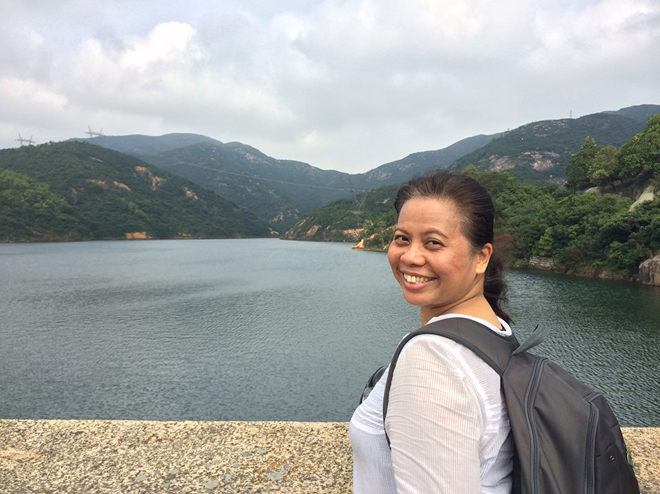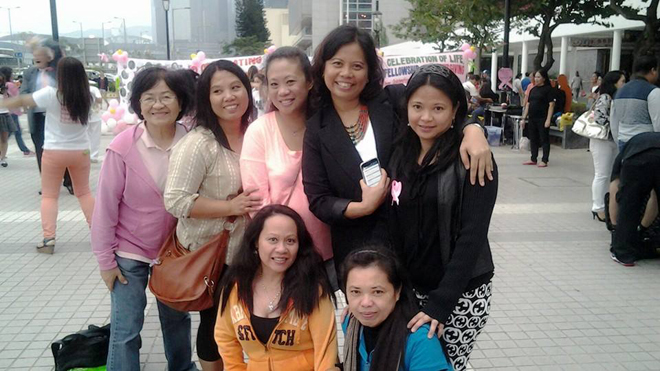From Fear to Friendship
By Beth Sabado

Beth Sabado, hiking in Hong Kong
The author recently finished a three-year term in Hong Kong as Coordinator of the Lay Missionary Central Leadership Team and is currently awaiting a new assignment.
My pilgrimage in, indeed my conversion to, interreligious dialogue started even before I learned the meaning of the word dialogue. Both my parents were from Luzon in the northern Philippines, but in 1946, soon after World War II, my father decided to migrate south to Pagadian, Zamboanga del Sur. At the time the town, which became a city in 1969, was predominantly Muslim, according to my father. My mother had a similar migration story and so my parents, even though neither was born there, met and married in Mindanao.
Mindanao, a little larger than Ireland, is the second largest island in the Philippines and is a place where sizeable numbers of Muslims and Christians dwell together.

Beth Sabado, friends in HK
At home, we spoke the language of my parents, Ilokano, the predominant language in northern Luzon, rather than Cebuano, the language of the south. This only stirred my curiosity about Cebuano and, unknown to my parents, I even tried to learn some of it. As a child, simply by listening to my playmates, I was already speaking Cebuano before I was aware of it.
As I was growing up, my parents were continually talking about going to court because of a land dispute. My father held a title proving his ownership of a piece of land, but the Muslim chief said that such a title was just a piece of paper and that the real owners of the land were his ancestors.
For us this was a strange notion of private property. This land dispute created an atmosphere of fear and we felt a coldness and ambivalence towards Muslims. These feelings were not confined to our immediate family, but they certainly contaminated our relatives and the families of the tenants on our farm.
After finishing college and passing the nursing exams up north, I went to Pagadian City where I spent nine years working in J. Cabahug Hospital and became Head Nurse. My nine years there not only enhanced my nursing skills, but also taught me to show respect to all the clients coming to the hospital and to begin to appreciate social and cultural differences. It gave me a great opportunity to build rapport with Muslims and to get to know them as persons. They were our main clients.
My previous assumption that Muslims were land-grabbers and criminals was gradually replaced by a relationship of empathy and respect. I became not only their nurse, but their friend. It helped liberate me from fear, mistrust and ambivalence.
Our school books contained simple explanations about beliefs, practices and rituals of other religions, but the books I read did not deal much with how to respect and celebrate our differences.
To fully understand and appreciate religious and cultural differences, I believe that we must have a complete head-to-heart conversion. For me, this involved changing my long held perspective from seeing God as associated with Church and primarily with Christians, to seeing God as a person who is present to all peoples and present in all religions.
In 2002, when I joined the Columban Lay Missionaries, the subject of interreligious dialogue was part of our orientation. It affirmed my earlier conviction that differences of beliefs should not be the basis for defining who we are, but, rather should be a space in which to understand and respect one another.
I worked for nine years in the migrant ministry at the Hope Workers’ Centre in Taiwan. There we assisted migrant works from Indonesia, Thailand, Vietnam, the Philippines and Cambodia.
Given the countries that most of the migrant workers came from, I was able to encounter a variety of religions. I found that people’s religious beliefs and background are important aspects of their ability to understand and cope with their situation.
I am reminded of a telephone call I received at the crack of dawn from the Taiwanese parish priest of the church where the Hope Workers’ Centre is based. (Read Beth’s Walking with Overseas Workers) He was apologetic, but he appealed to me to go to the center as soon as possible, because a migrant worker had been brought by a taxi driver and seemed to be in a lot of pain. I rushed on my motorbike to the center. [Link ‘Walking with Overseas Workers’ to http://www.misyononline.com/new/may-jun2006/walking-with-overseas-workers ]
There I saw a man soaked in blood, lying curled in front of the gate of the church, moaning in pain. Some neighbors had gathered around helplessly. When I arrived, they explained that he was an Indonesian migrant worker who had been locked up by his broker.
Afraid he would be repatriated to his homeland, he managed to escape through a second-floor window by knotting his clothes and a blanket together. When the knot gave way he fell from a height, but managed to crawl beside the road until a taxi driver helped him and drove him to the church.
The human dynamics in that scenario made me reflect. I had been summoned to that man. I pray that when a stranger needs help my response will be spontaneous, because I see Christ in him.Our life journey has to be grounded in trust and in the goodness found in the diversity of our beliefs and cultures.
It is my hope that one day people will call each other by name and not by labels of creed and race.
This is how I see God - no limits, no boundaries, but a Being who is present to everyone, and in the midst of every group, regardless of ‘tribe and tongue, people and nation’ (Revelations 5:9).
You may email the author at madamsaturday.ms@gmail.com
